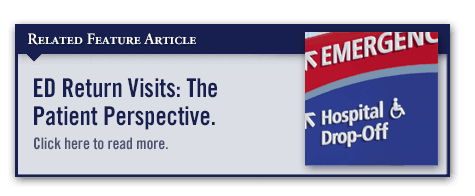In 2012, CMS implemented reimbursement penalties for hospitals with excessive inpatient readmissions for patients with several diagnoses. As a result, many interventions have been developed in an effort to reduce inpatient readmissions. Though there are currently no similar penalties for recurrent ED visits, there has been increasing attention on tracking and reducing 72-hour ED returns. “Return visits within an acute time period after ED discharge warrant a closer look to determine the reasons for the return and which visits may have been preventable,” explains Kristin L. Rising, MD, MS. “We must use care in defining the metrics on which we base our studies. This can start by examining what reasonably qualifies as the ‘acute time period’ during which patients are most likely to have a return ED visit.”
Quantifying ED Revisits
ED revisits that occur within 3 days of ED discharges are commonly used as a hospital quality metric, but Dr. Rising says there is no clear basis for this time threshold being the most appropriate. “We need to determine the most appropriate time period to use in identifying patients at highest risk of unexpected ED revisits before we develop targeted strategies to predict and prevent these occurrences,” she says. To address this issue, Dr. Rising and colleagues conducted a study—published in Academic Emergency Medicine—to characterize the timing of return ED revisits after prior ED discharges.
According to the findings, over 7% of ED discharges assessed in the study had ED revisits within 3 days, and over 22% of ED discharges had revisits within 30 days. When statistical models were applied to the data, the most reasonable cutpoint for identifying acute ED revisits was 9 days. “Our findings suggest that 3 days is an inadequate time period to capture acutely returning ED patients,” says Dr. Rising. “Though time periods may vary based on specific outcomes of interest, our data suggests that 9 days is a more appropriate overall time period to use when examining ED revisits,” Dr. Rising says.
An Important First Step
Dr. Rising says her study team’s analysis is an important first step in starting conversations on how and whether to use ED returns as a quality measure. “Our findings have implications for future research and for improving the quality of healthcare delivery,” she says. “Further work is needed to determine whether there are distinct and important differences between patients returning in different time periods. We suggest that development of future quality measures focus primarily on identifying reasons for potentially avoidable return ED visits instead of focusing solely on the occurrence of a revisit itself. This will enable us to more directly measure potential lapses in the delivery of care.”




 TimH
TimH